A Visit to Locarno and the Sanctuary of Madonna del Sasso
This destination guide covers the sights of the picturesque city of Locarno in Switzerland, including a visit to the Sanctuary of Madonna del Sasso.
Locarno visit
After a scenic train trip across the Gotthard from Lucerne, I had finally arrived in Locarno, the next destination on my travels through Switzerland.
Locarno is one of the main cities in the Italian-speaking Swiss Canton of Ticino, famed for its prestigious Locarno International Film Festival, which takes place annually in the city and involves open-air screenings in the main square.
Locarno is also a popular stop on the Swiss tourist trail, and many people travel to the city each year to admire its picturesque setting on Lake Maggiore or to visit sights such as the hilltop Sanctuary of Madonna del Sasso.
Upon my arrival in the evening, I went straight to sleep at my accommodation, a simple but clean single room with balcony and a shared bathroom above a local restaurant called Osteria Pozzo, for which I paid 72 Swiss francs (€76 — yes, accommodation in Switzerland is expensive).
After a good night’s sleep, I woke up well-rested and ready to explore the sights of Locarno.
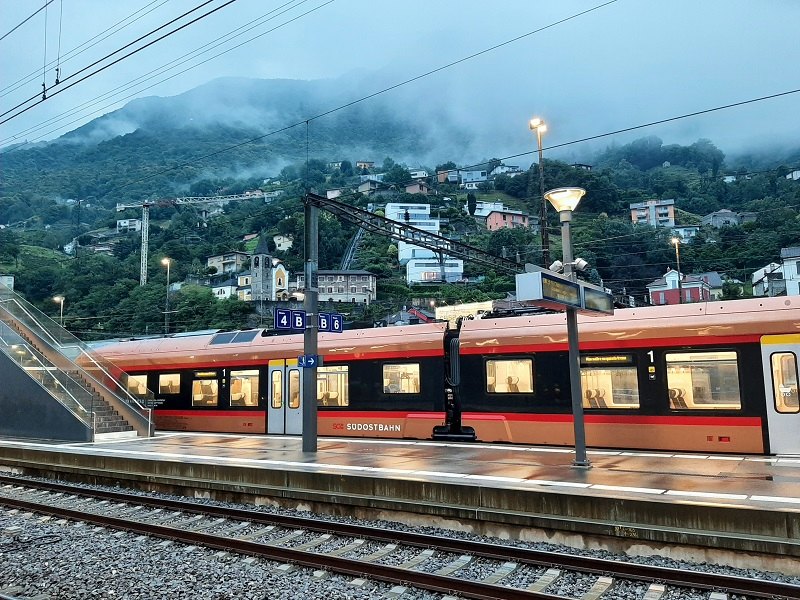




A morning walk through the old town
Although I only had half a day to explore Locarno, I was eager to fully absorb the Italianesque atmosphere in this southern corner of Switzerland.
I was happy to see that after the rather mixed weather during my previous days travelling around Switzerland, there were gorgeous blue skies over Locarno this morning, with the sun shining brightly.
As my accommodation was located on Piazza Sant’Antonio in the heart of the city centre, all I needed to do was walk out the front door to begin my tour of Locarno, starting at the Parish Church of Saint Anthony Abbot (Parrocchia Cattolica Sant’Antonio Abate) at the opposite end of the square.
Construction of the Parish Church of Sant’Antonio Abate began in 1664, and it was consecrated in 1692, although the clock tower was only added later during the mid-18th century.
From the square, I walked into one of the narrow pedestrianised streets of Locarno’s old town, which were still mostly empty at this early hour of the morning.
Although Locarno’s old town isn’t large, it does have a few charming streets that feel more Italian than Swiss in character.
Also the palm trees in some of the streets and gardens clearly indicated that I was now firmly south of the Alps in Italian-speaking Switzerland, rather than in the German-speaking part where I had spent the previous day.

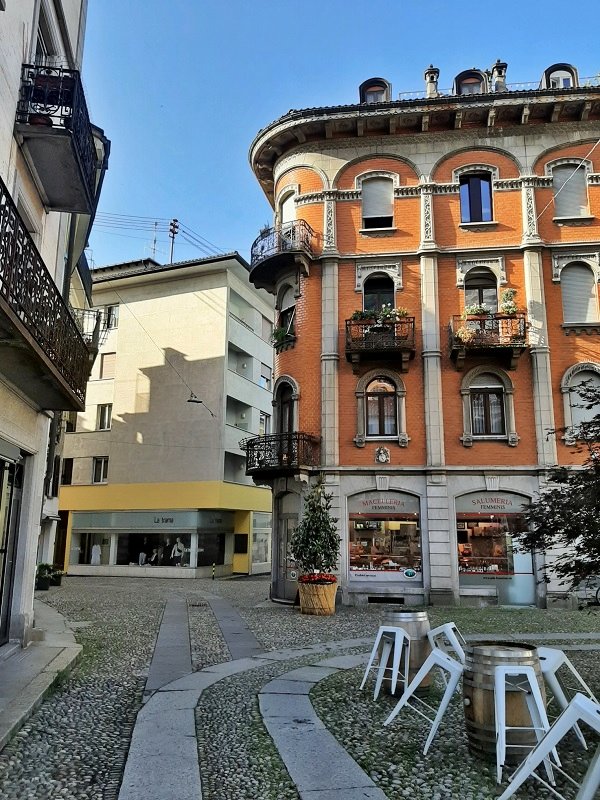



Saint Francis Church
Another important church in Locarno is the Church of Saint Francis of Assisi (Chiesa di San Francesco d’Assisi), which dates back to 1316.
However, the current church building, with its Romanesque façade, dates back to 1583.
Adjacent to the church is a former convent of the Friars Minor, which is now used as a teachers’ college.
In the immediate surroundings, you can also find a monument dedicated to Giovanni Battista Pioda, a 19th-century Swiss politician and member of the Swiss Federal Council, who was born in Locarno.




Museo Casorella
Near the Church of Saint Francis, you can find two other Locarno sights: The Museo Casorella and Visconti Castle.
Housed in a 16th-century mansion, Museo Casorella serves as Locarno’s local art museum.
The art museum features three permanent exhibits: a collection of works made or donated by Jean Arp and his wife Marguerite, paintings by Locarno’s most famous artist, Filippo Franzoni, and a sculpture park showcasing works by Max Bill.

Visconti Castle and the Locarno Treaties
Right next to Museo Casorella is the Visconti Castle (Castello Visconteo), which dates back to the 14th century.
Much of the castle’s fortifications were destroyed after Ticino was annexed by the Swiss Confederation in the early 16th century.
Only the central part of the castle and one of its towers survived, which were used as a governor’s office and district court.
Between 1921 and 1928, Visconti Castle underwent extensive renovations, after which it has been used as the city’s archaeological museum.
In Visconti Castle, you can also find an exhibition about the Locarno Treaties, which were negotiated following a peace conference held in the city in October 1925 (though they were formally signed two months later in London).
The Rhineland Pact, signed by Germany, France, the United Kingdom, Belgium, and Italy, was the was the most important of the Locarno Treaties.
This pact was intended to normalise relations following World War I and to secure a permanent post-war territorial settlement in Western Europe.
Germany formally recognised its new western borders as established by the Treaty of Versailles and renounced the use of force to alter them, while Germany, France, and Belgium all promised not to attack each other, with the UK and Italy acting as guarantors.
As a result of the Rhineland Pact, the occupation of the Rhineland by Allied forces would end in 1930, a full five years earlier than previously agreed at Versailles.
However, regarding its eastern borders, Germany only agreed to arbitration with Czechoslovakia and Poland, and while France promised military aid to these two Central European states in the event of an unprovoked attack by Germany, the UK did not offer any guarantees.
In what was called the “spirit of Locarno”, the treaties generated some new sense of optimism in Europe, although these hopes for a permanent peace were quickly dashed when Hitler came to power in Germany and remilitarised the Rhineland in 1936, denouncing the Locarno Treaties.



Piazza Grande
One of the most picturesque spots in Locarno is Piazza Grande, the lively main square that forms the heart of the old town.
This large public square is lined with some of Locarno’s most beautiful historic buildings, many featuring Lombard-style porticoes, arcades, and painted façades in soft pastel colours.
Piazza Grande is a beloved meeting place for the locals and also hosts many of Locarno’s major events, such as the Locarno International Film Festival, usually held in early August, and Winterland, a Christmas market featuring an ice skating rink and ice slide, typically held from mid-November to the beginning of January.
Every Thursday, a market takes place on this Locarno square, with stalls selling fruit and vegetables, local delicacies, clothes, and much more.
When I visited the square in the early morning, most of the local salesmen and women were still in the process of setting up their stalls for the day.

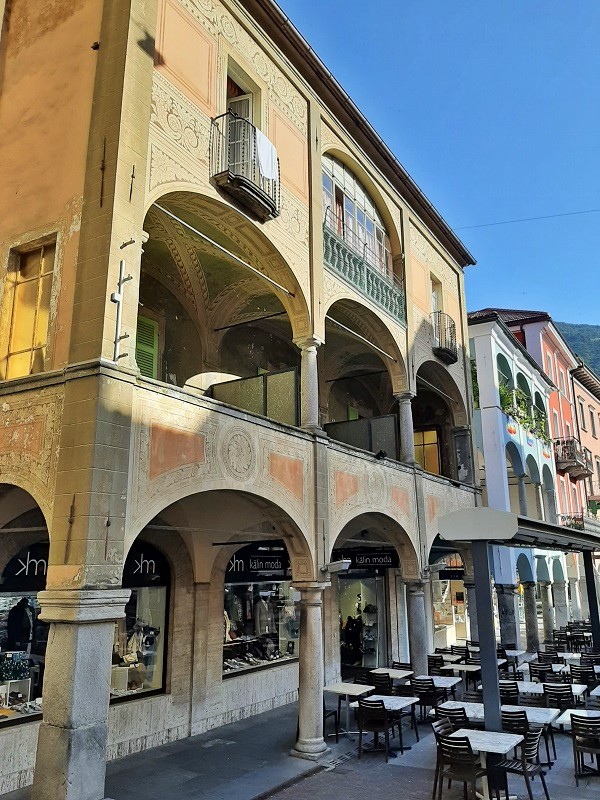




Walking to the lake
After my visit to Locarno’s weekly market on Piazza Grande, I strolled through some of the old town’s side streets radiating from the square.
There are many more fine buildings and shopping arcades to admire, but as the old town isn’t large, it won’t take long to walk through every street.
I therefore left the old town and walked towards the waterfront, passing the local casino and theatre in what clearly felt like a more modern part of the city.


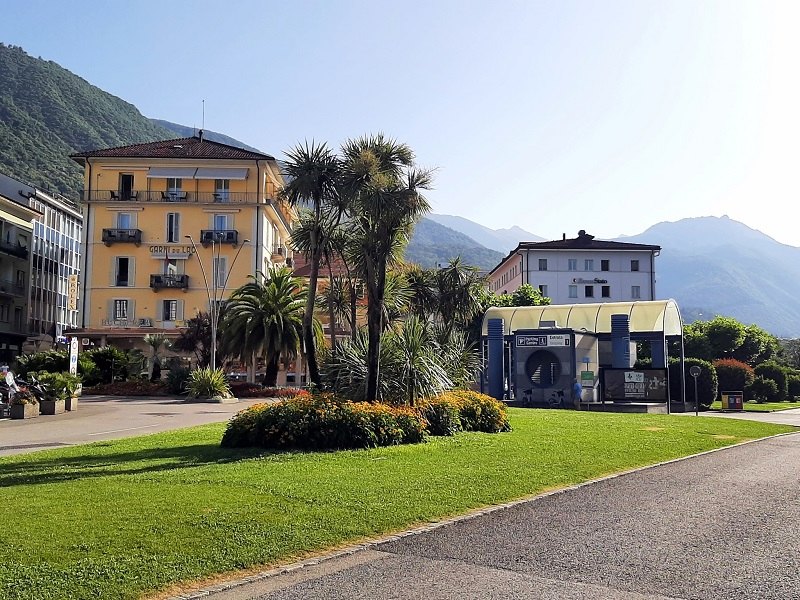



Locarno lakeside promenade
One of Locarno’s primary attractions is its gorgeous setting on Lago Maggiore, and the contrast of the blue waters of the lake with the backdrop of green forested mountains is certainly stunning.
Located on the southern side of the Alps, Ticino’s climate is certainly warmer than in the rest of Switzerland, and you’ll immediately notice this when comparing the Locarno lakeside with other major lakes in the country to the north of the Alps, such as Lake Geneva or Lake Zurich.
Locarno has an inviting lakeside promenade hugging the shore of Lago Maggiore, and in sunny weather, it is an excellent place for a stroll or to sit on a bench and relax for a while while taking in the views.
There are also a few jetties from which you can catch a tourist excursion boat or a regular ferry service to destinations across Lake Maggiore.
Navigazione Lago Maggiore operates a ferry service across Lake Maggiore from Locarno to Ascona, Isole di Brissago, Stresa, Arona, and many other destinations around the lake in both Switzerland and Italy, although you may have to change boats midway.




Madonna del Sasso funicular
The most famous of Locarno’s sights is the Sanctuary of Madonna del Sasso, perched on a mountaintop high above the city.
The easiest way reach the Sanctuary of Madonna del Sasso is by taking the funicular up the mountain.
From both Piazza Grande and the lakeside promenade, the lower station of the Madonna del Sasso funicular is just a short walk away.
In the summer season (April to October) there is a funicular departing every 15 minutes, while in the winter season (November to March) it only departs every 30 minutes.
The adult fare for the Locarno-Madonna del Sasso funicular is 5.40 CHF (€5.70) for a one-way ticket or 8 CHF (€8.44) for a return ticket, while children aged 6 to 16 pay 2.40 CHF (€2.53) and 4 CHF (€4.22), respectively.
If you have a Ticino ticket, you receive a 20% discount on the funicular, while a Swiss Travel Pass entitles you to a 25% discount (on round trips only).
It’s a fun ride up on the single-track funicular, which has a passing loop halfway up the incline where the downhill funicular passes the car making the uphill journey.
The Locarno-Madonna del Sasso funicular was built in 1906 and takes you from the bottom station at an altitude of 205.8 metres above sea level to the upper station, which is 172.5 metres higher up the mountain.
The length of the track is 813 metres, and the maximum gradient of the funicular is 30%.
Make sure to stand at the front of the funicular for great views towards the Sanctuary of Madonna del Sasso and the track ahead, or at the rear if you prefer to look back over the track and enjoy the views of Locarno and Lake Maggiore.
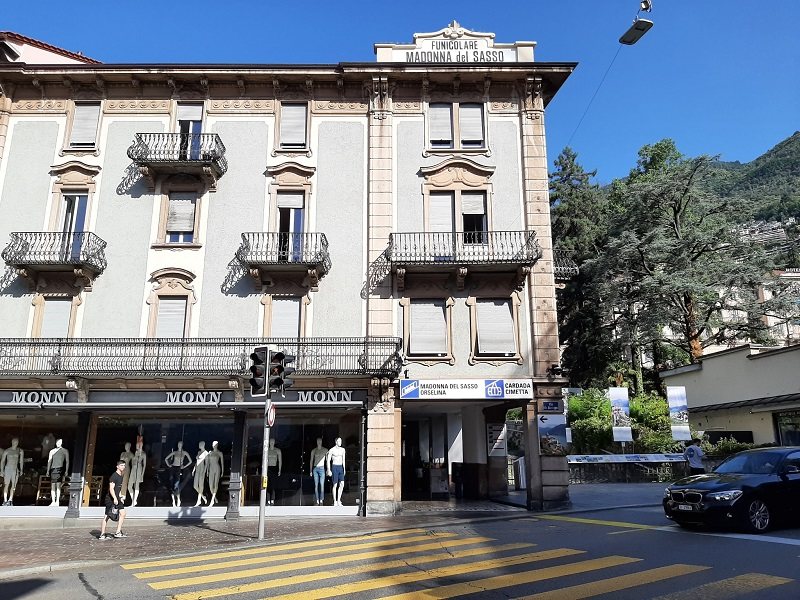


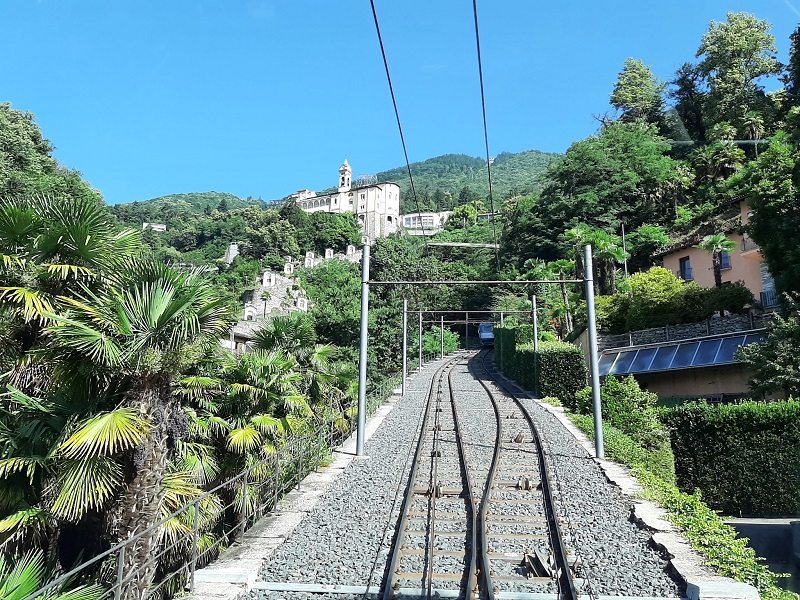




Sanctuary of Madonna del Sasso
Once you exit the funicular at the upper station you will find yourself in Orselina, a small municipality which is part of the Locarno district.
From the upper funicular station, the Sanctuary of Madonna del Sasso is just a short walk away, although before starting your visit, you will want to stop to take in the lovely views of this picturesque shrine along with the city of Locarno and Lake Maggiore down the mountain.
As you exit the upper funicular station, walk a few dozen metres to your left along the main road to reach the viewpoint with the best views over Madonna del Sasso and Locarno.

Visiting Madonna del Sasso
The Sanctuary of Madonna del Sasso is not only one of Locarno’s most important historical and religious sights, but even of the entire Ticino.
In 1480, in the mountains high above Locarno on the evening preceding the Feast of the Assumption, Franciscan friar Bartolomeo de Ivrea received a vision in which the Virgin Mary appeared before him.
A few years later, in 1487, it was decided to found a sanctuary at the site of the Marian apparition.
The Sanctuary of Madonna del Sasso is free to visit, and the path to this Catholic shrine starts immediately across the road from the upper funicular station.
Note that there are some stairs involved in reaching the sanctuary, although stairlifts are available for visitors with physical limitations (contact the sanctuary in advance to arrange their use).

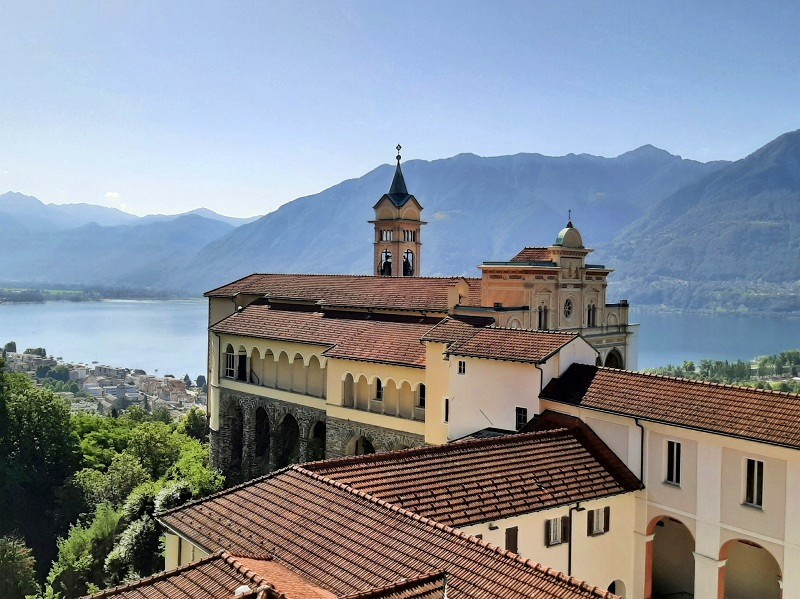






Marian shrine
The complex of Madonna del Sasso consists not only of the sanctuary itself but also of a convent, a church, several chapels, and the Stations of the Cross.
At the heart of the Sanctuary of Madonna del Sasso is a shrine with an image of the Virgin Mary, which received a pontifical decree of coronation from Pope Leo XIII in 1880, exactly 400 years after the Marian apparition.
Don’t forget to walk through the cloister of the Sanctuary of Madonna del Sasso, as you can enjoy sweeping views over Locarno and Lake Maggiore from here.
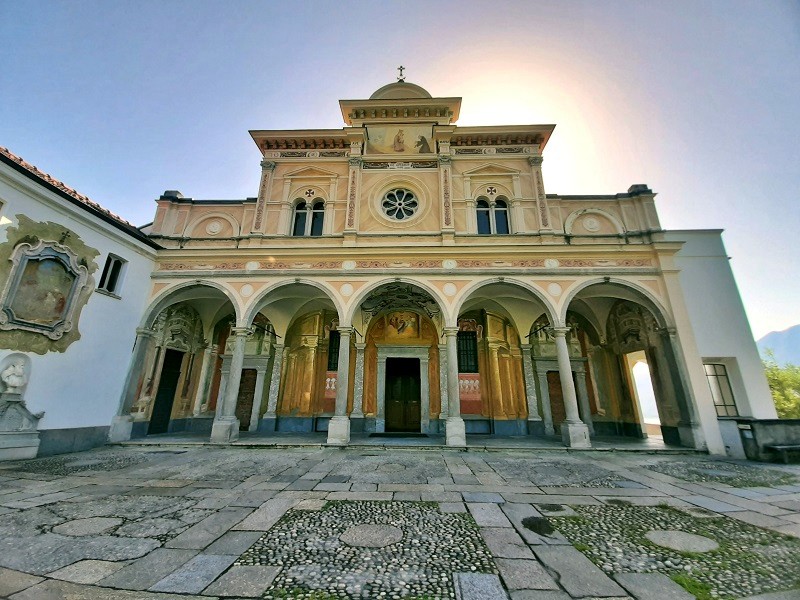
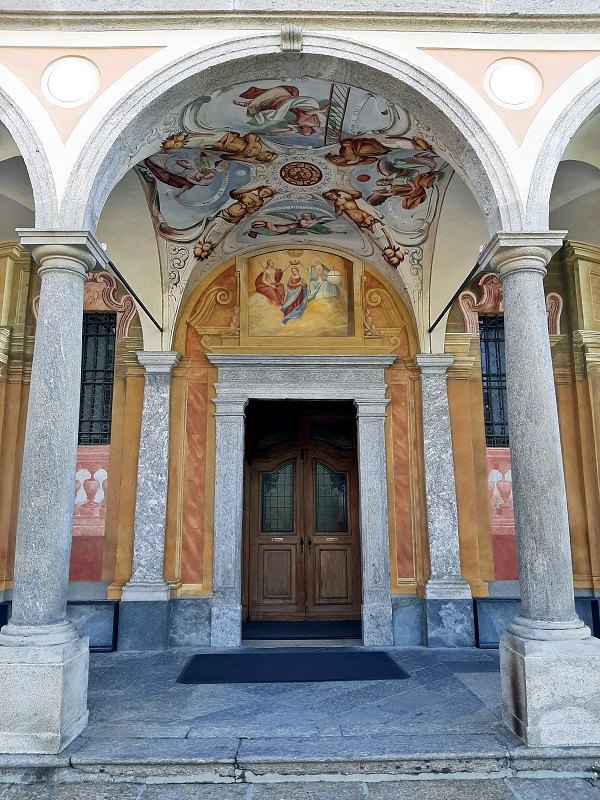


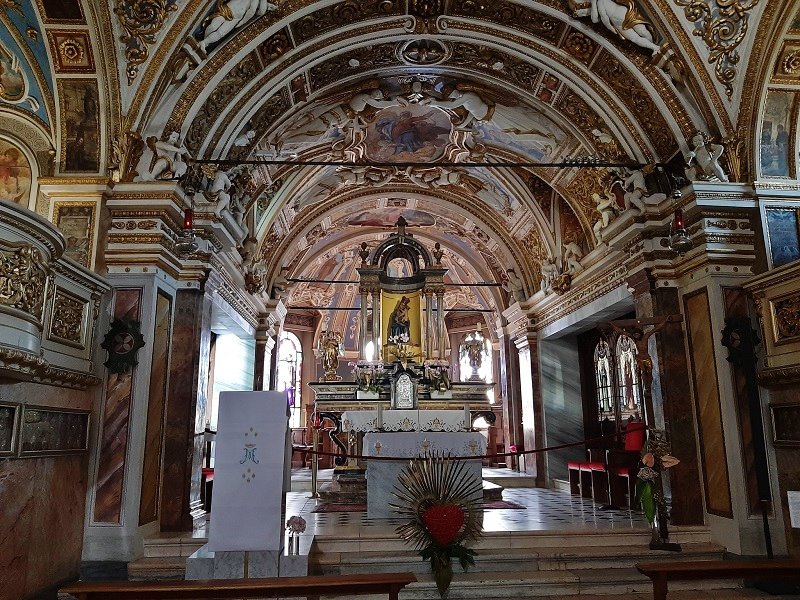




Down the mountain
After my visit to the Sanctuary of Madonna del Sasso, I exited the complex and sat down at the terrace of a restaurant along the main road for a drink, allowing myself to take in the lovely views over Locarno for a bit longer.
When you find yourself in Orselina, you can take a cable car that takes you even higher into the mountains, although I decided to head back down with the funicular.






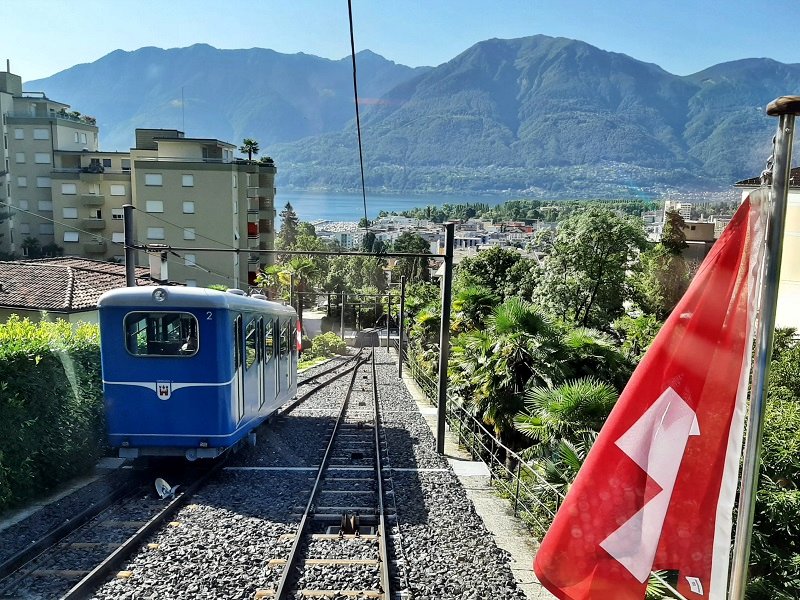
Centovalli Railway
Another of Locarno’s sights isn’t actually located in the city itself but will take you out of it.
I’m talking, of course, about the Centovalli Railway that connects Locarno with Domodossola, which is just across the border in Italy.
The Centovalli Railway, regarded as one of the most scenic train rides in all of Switzerland, takes you through the stunning Centovalli (which literally means ‘hundred valleys’) region west of Locarno.
In the next chapter of this trip report, I’ll take a train across the scenic Centovalli Railway line, so stay tuned for that!



Conclusion
Locarno, located in Switzerland’s Italian-speaking canton of Ticino, is a highly picturesque city on the shores of Lake Maggiore.
There are several sights to visit in Locarno, such as Visconti Castle and Museo Casorella, although much of the city’s charm lies in strolling around beautiful Piazza Grande, the old town streets, or along the lakeside promenade.
Of all Locarno’s sights, the Sanctuary of Madonna del Sasso is a must-visit.
You can reach this Catholic shrine perched high on a mountain by taking the funicular from Locarno’s city centre to Orselina, from where the Sanctuary of Madonna del Sasso is just a short walk away.
Taking a boat ride across Lake Maggiore or hopping on a train along the scenic Centovalli Railway are also must-do activities if you find yourself in Locarno.
Trip report index
This article is part of the ‘Scenic Trains Around Switzerland and the Italian Lakes‘ trip report, which consists of the following chapters:
1. Bergamo: A Visit to Lombardy’s Beautiful Hilltop Town
2. Travelling From Bergamo to Milan by Train
3. From Milan to Varenna and Tirano By Trenord Regional Train
4. A Varenna Visit: A Day Trip to Lake Como’s Most Beautiful Town
5. Tirano: The Italian Gateway to the Bernina Railway
6. Bernina Express Train: Guide to Switzerland’s Most Scenic Railway
7. Review: Swiss InterCity (IC) Train Chur to Zurich and Basel
8. From Zurich to Geneva on a Swiss ICN Tilting Train
9. Cheap Geneva Hotel: Stay Across the Border in Annemasse!
10. Around Lake Geneva by Train: From Geneva to Montreux
11. A Visit to Montreux and the Freddie Mercury Statue
12. Golden Pass: Guide to a Scenic Railway Route Across Switzerland
13. Swiss Chique: The MOB GoldenPass Belle Époque Train
14. From the Mountains to the Lake: Zweisimmen to Spiez by Train
15. Spectacular Spiez: A Visit to a Scenic Swiss Town
16. Spiez to Interlaken by Train: A Trip on the Lake Thun Railway Line
17. Review: Interlaken to Lucerne by Zentralbahn Train
18. Lucerne: Exploring One of Switzerland’s Most Beautiful Cities
19. From Lucerne to Locarno: By Train Across the Gotthard
20. A Visit to Locarno and the Sanctuary of Madonna del Sasso (current chapter)
21. Centovalli Railway: By Train From Locarno to Domodossola
22. Stresa: Grand Hotels, Lakeside Views, and the Borromean Islands
23. Review: Trenitalia Frecciarossa High-Speed Train Milan to Bologna

